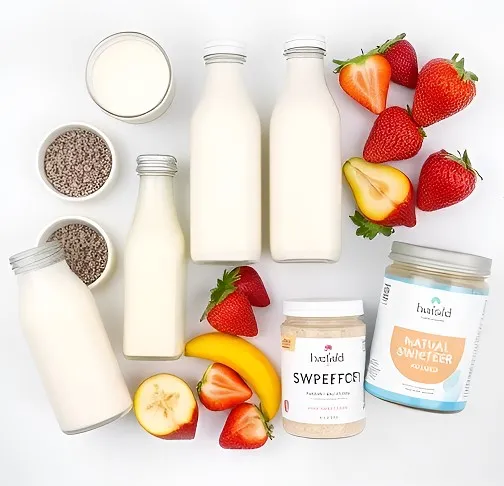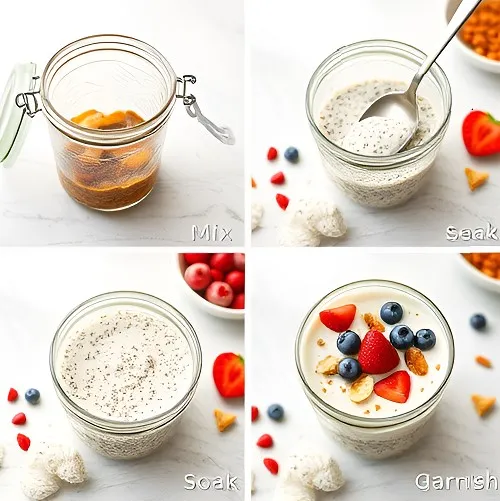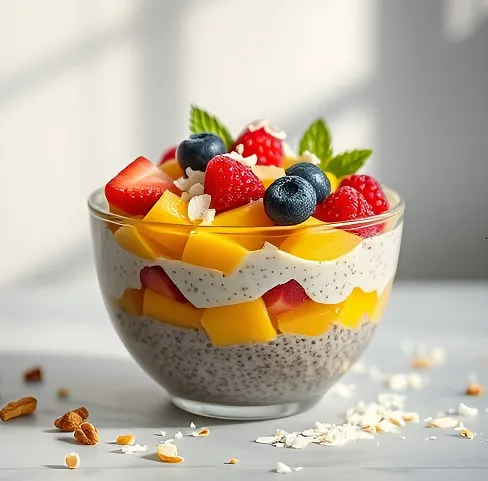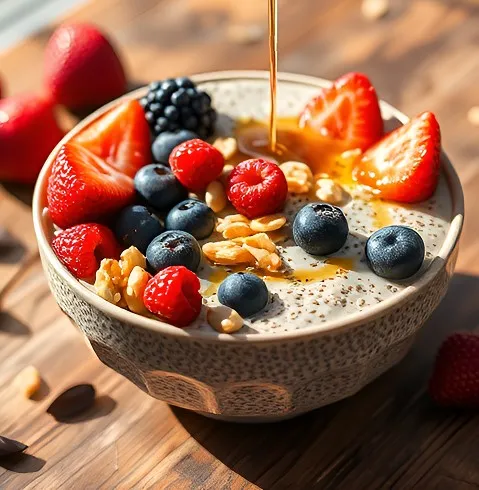In today’s fast-paced world, finding a quick, nutritious, and delicious meal or snack can sometimes feel like a challenge. That’s where protein chia pudding comes into play. This vibrant, versatile dish has become a favorite among health enthusiasts, busy professionals, and foodies alike. Whether you’re searching for a hearty breakfast or a satisfying mid-day snack, protein chia pudding fits the bill perfectly. In this article, we’ll dive deep into what makes protein chia pudding so special, explore its nutritional benefits, and answer some key questions such as: Is chia pudding a good source of protein? Can I add protein powder to chia seed pudding? How much protein is in 1 cup of chia pudding? And how much protein is in 2 spoons of chia seeds?
Table of Contents
The Rise of Chia Seeds in Modern Diets
Chia seeds, those tiny, unassuming specks, have come a long way from their ancient origins in Central and South America. Once a staple in the diets of the Aztecs and Mayans, chia seeds were prized for their ability to provide sustainable energy, making them a favored food among ancient warriors. Today, they are celebrated worldwide for their impressive nutritional profile. Chia seeds are loaded with omega-3 fatty acids, fiber, antioxidants, and, yes, protein. With these benefits, they have seamlessly integrated into the trends of modern, clean eating.
The Basics of Protein Chia Pudding
At its core, protein chia pudding is made by soaking chia seeds in a liquid (such as milk or a plant-based alternative), which causes them to expand and form a gel-like consistency. This transformation, which happens overnight or in just a few hours, is the essence of the pudding’s unique texture. The chia seeds’ ability to absorb liquid creates a thick, creamy base that can be enjoyed on its own or transformed into a canvas for additional flavors.
A classic version of the pudding includes just a few ingredients:
- Chia seeds
- Your choice of milk (dairy, almond, coconut, or soy)
- A natural sweetener (honey, maple syrup, or stevia)
- Flavor enhancers like vanilla extract, cocoa powder, or a sprinkle of cinnamon
But what sets the “protein” chia pudding apart is the boost of protein, whether it comes naturally from the seeds, additional ingredients like milk, or the incorporation of protein powder. This boost makes the chia pudding not only delicious but also a balanced meal option that can help build and repair muscles, keep you satiated, and sustain energy levels throughout the day.
Nutritional Benefits of Protein Chia Pudding
Chia pudding isn’t just eye-catching on the plate—it’s also a powerhouse of nutrients. Let’s explore why incorporating this pudding into your routine is a smart nutritional choice.
Rich in Omega-3 Fatty Acids
One of the defining features of chia seeds is their high omega-3 fatty acid content. Omega-3s are crucial for heart and brain health. They reduce inflammation, help regulate cholesterol levels, and contribute to overall cardiovascular wellness. Adding chia seeds to your diet can be a natural way to boost your intake of these essential fats.
Excellent Source of Dietary Fiber
With around 10 grams of fiber per ounce, chia seeds are among the top natural sources of dietary fiber. This fiber aids in digestion, helps regulate blood sugar levels, and contributes to lasting satiety, making protein chia pudding an excellent option for those looking to maintain steady energy levels and manage weight.
Plant-Based Protein
Chia seeds are a plant-based protein source that provides about 4 to 5 grams of protein per two tablespoons. They might not match the protein content found in meat or legumes, but when combined with other protein sources like dairy or added protein powder, protein chia pudding becomes a well-rounded, nutrient-dense meal.
Packed with Micronutrients
Beyond fiber, chia seeds are also rich in calcium, magnesium, phosphorus, and antioxidants. These micronutrients are vital for bone health, energy production, and protecting the body against free radicals. A bowl of protein chia pudding can serve as a mini nutritional bomb, delivering a variety of vitamins and minerals with every spoonful.
Is Chia Pudding a Good Source of Protein?
This is a question that surfaces frequently, especially among athletes and those committed to a high-protein diet. The answer is nuanced. Chia pudding is indeed a good source of protein, especially when prepared with protein-rich liquids like dairy milk or when enhanced with protein powder. While chia seeds alone contribute a modest amount of protein, they serve as a versatile base that can be enriched to meet your dietary needs.

Can I Add Protein Powder to Chia Seed Pudding?
Absolutely! Adding protein powder to chia seed pudding is a practical and delicious way to boost the protein content without sacrificing flavor or texture. Many health enthusiasts and athletes find that mixing in a high-quality protein powder transforms their chia pudding into a more complete meal that can sustain them through busy mornings or post-workout recovery sessions.
When adding protein powder, it’s best to choose a flavor that complements your pudding. Vanilla, chocolate, or unflavored varieties work well, depending on your desired taste profile. Here are a few tips to keep in mind when incorporating protein powder:
- Mixing It Right: Add the protein powder to your base liquid before stirring in your chia seeds. This helps ensure the powder dissolves evenly, making for a smooth, creamy consistency.
- Quantity Considerations: The amount of protein powder you add depends on your personal protein goals. One scoop typically provides around 20-25 grams of protein, which, when mixed into a serving of chia pudding, can turn it into a truly protein-packed dish.
- Experiment with Flavors: Protein powders come in many flavors. Experiment with cocoa, vanilla, or even berry-flavored powders to create unique versions of your pudding.
How Much Protein is in 1 Cup of Chia Pudding?
The protein content of one cup of chia pudding can vary widely depending on the recipe. A standard chia pudding made with a quarter cup of chia seeds and one cup of a protein-fortified liquid (such as dairy or soy milk) naturally offers more protein than one made with non-dairy options like almond milk. On average, if you prepare your chia pudding with a base that provides around 8 grams of protein per cup (like cow’s milk), plus the contribution of the chia seeds (roughly 7 grams from a quarter cup), you are looking at a total that can range from 12 to 15 grams of protein per cup.
For those who are conscious about their protein intake, consider these adjustments:
- Using a higher-protein milk alternative such as soy or pea milk can naturally increase the protein content.
- Adding protein powder not only boosts protein but also adds a creamy texture if the pudding is prepared correctly.
- Topping your pudding with nuts or seeds, such as almonds or hemp seeds, will further enrich its protein profile.
These variations make it easy to tailor the recipe to your specific dietary needs without compromising taste.
How Much Protein is in 2 Spoons of Chia Seeds?
When discussing measurements, “2 spoons” typically refer to two tablespoons of chia seeds. This small serving is a concentrated source of nutrition. Two tablespoons (roughly 28 grams) of chia seeds generally contain about 4 to 5 grams of protein. While this may not seem like much on its own, remember that chia seeds are packed with other essential nutrients like fiber and omega-3 fatty acids. In the context of a balanced protein chia pudding recipe, even this modest protein addition works effectively together with other ingredients to create a nutritionally complete dish.
A Closer Look at the Science
To better understand the role of protein in your chia pudding, it helps to explore what protein does for your body. Proteins are the building blocks of life. They contribute to muscle repair, hormone production, and the maintenance of bodily tissues. A mixture of complete and complementary proteins in your diet helps ensure that your body has all the essential amino acids needed for optimal function.
Chia seeds, while not a complete protein (they do not contain all essential amino acids in the ideal ratios), still add a valuable protein component, especially when combined with other ingredients. Dairy or soy milk, for example, does offer a complete protein profile, which means that a protein chia pudding made with these liquids can be considered a balanced snack or meal.
A Step-by-Step Guide
Now that we’ve explored the science and nutrition behind protein chia pudding, let’s get into creating your own delicious version at home. This recipe is simple, customizable, and perfect for meal prep.
Ingredients:
• 1/4 cup chia seeds (approximately 40 grams)
• 1 cup of milk or milk alternative (dairy, almond, soy, or pea milk)
• 1-2 teaspoons of natural sweetener (like honey, maple syrup, or agave)
• 1/2 teaspoon of vanilla extract (optional)
• A pinch of salt
• Optional: 1 scoop of protein powder (vanilla, chocolate, or unflavored) for an added protein boost
• Your favorite toppings (fresh fruit, nuts, coconut flakes, cacao nibs, or shredded coconut)
Instructions:
Start by selecting a clean jar or bowl for mixing. Pour your choice of milk into the container. If you’re adding protein powder, whisk it thoroughly into the milk first to ensure it dissolves completely without any clumps. Next, stir in the chia seeds, natural sweetener, vanilla extract, and a pinch of salt. Mix everything gently to combine all the ingredients evenly.
Cover the container with a lid or plastic wrap and place it in the refrigerator. Allow the mixture to sit for at least 4 hours, or ideally overnight. During this time, the chia seeds will absorb the liquid and swell up, creating that thick, pudding-like texture that makes this dish so irresistible.

After the pudding has set, give it a good stir to ensure that the consistency is even. If you find that the pudding is too thick for your liking, you can add a little extra milk and mix well. Now it’s time to add your favorite toppings. Fresh berries, sliced bananas, chopped nuts, or even a drizzle of extra honey can elevate the flavors and add extra nutritional value.
Customizing Your Protein Chia Pudding
One of the greatest strengths of protein chia pudding is its flexibility. You can easily tailor it to meet your personal taste and nutritional needs. For example, if you’re looking to increase your protein intake even further, consider adding:
• More protein powder or a different type of protein supplement, such as collagen peptides, for added health benefits.
• A dollop of Greek yogurt, which not only boosts protein but also adds a creamy tang to the pudding.
• A handful of nuts like almonds or walnuts, which are high in both protein and healthy fats.
For those who follow a plant-based diet and avoid dairy, many non-dairy milks (such as soy or hemp milk) naturally contain protein. Additionally, you can incorporate plant-based protein powder to ensure that your pudding meets your daily protein requirements. Experimenting with spices such as cinnamon, nutmeg, or even a hint of cardamom can also bring a new dimension of flavor to your pudding without adding unnecessary calories.
Health Benefits Beyond Protein
While protein is a key focus of this recipe, it’s important to recognize the additional health benefits that protein chia pudding offers. The omega-3 fatty acids in chia seeds have been linked to reduced inflammation and improved cardiovascular health. Moreover, the high fiber content aids digestion and supports a healthy gut microbiome. Regular consumption of chia seeds can contribute to better cholesterol levels and might even help regulate blood sugar levels—a crucial factor for long-term health.
The antioxidants present in chia seeds help combat oxidative stress in the body, protecting cells and supporting overall wellbeing. This means that, while you enjoy your protein chia pudding for its protein content, you’re also providing your body with other essential nutrients that support aging gracefully and maintaining overall vitality.
Integrating Protein Chia Pudding Into a Balanced Diet
Protein chia pudding can be a central part of a balanced diet. Here are a few ways you can integrate this recipe into your daily meal plan:
Start your day with a bowl of protein chia pudding as a hearty breakfast. Paired with a piece of fruit or a small serving of whole grains, it sets a positive tone, delivering sustained energy that carries you through your morning. As a mid-afternoon snack, it’s perfect for curbing hunger between meals. Even after a workout, when your body needs a quick recovery boost, a serving of protein chia pudding can be both refreshing and revitalizing.
For those who enjoy meal prep, protein chia pudding is an ideal candidate. Prepare a batch for the week, store it in individual containers, and have a nutritious snack ready whenever you need it. This not only saves time during busy mornings but also ensures you always have a healthy option on hand, reducing the temptation for less nutritious alternatives.
Addressing Common Questions
Through the journey of exploring this dish, numerous questions tend to arise. Let’s address some of the most common queries related to protein chia pudding.
Is chia pudding a good source of protein?
Yes, while chia seeds do not offer the highest levels of protein compared to more concentrated sources, they do contribute a solid, plant-based protein hit on their own. When combined with other ingredients such as milk, yogurt, or protein powder, chia pudding becomes an excellent protein source that supports muscle repair and overall health. Its rich combination of protein, fiber, and healthy fats makes it a multidimensional food, supporting various aspects of physical wellness.
Can I add protein powder to chia seed pudding?
Absolutely. Adding protein powder to chia seed pudding is a popular way to boost its nutritional profile further. Whether you choose whey, plant-based, or collagen protein powders, mixing them into your pudding is a seamless process. Just blend the powder into your chosen liquid before adding the chia seeds to avoid clumping. This simple addition transforms your pudding into an even more compelling option for those who require higher protein intake—especially after workouts or on days when you need an extra nutritional boost.
How much protein is in 1 cup of chia pudding?
The protein content in 1 cup of chia pudding can vary depending on the recipe. If you use a base like cow’s milk that has around 8 grams of protein per cup along with the chia seeds (which provide approximately 7 grams from a quarter cup), you can expect roughly 12 to 15 grams of protein per cup. Opting for higher-protein milk alternatives or adding protein powder can push that number even higher, making your pudding a more potent source of protein.
How much protein is in 2 spoons of chia seeds?
Typically, “2 spoons” refers to about two tablespoons of chia seeds, which usually provide around 4 to 5 grams of protein. While this amount might seem modest, remember that chia seeds also offer significant amounts of fiber and omega-3 fatty acids. Thus, even a small serving contributes meaningfully to the overall nutritional profile of your chia pudding, especially when combined with other protein-rich ingredients.
Creative Variations on Protein Chia Pudding
One of the most exciting aspects of protein chia pudding is its versatility. Once you master the basic recipe, you can experiment with different ingredients and flavor combinations to suit your taste preferences and dietary goals. Here are a few creative variations to consider:
Chocolate Protein Chia Pudding:
Mix cacao powder with your base liquid before adding chia seeds. Add a scoop of chocolate-flavored protein powder and a touch of honey or maple syrup for extra sweetness. Top with sliced bananas or a sprinkle of cocoa nibs for a decadent, yet healthy treat.

Berry Blast Chia Pudding:
Use a blend of almond or soy milk and add a handful of fresh or frozen berries to the mixture. The berries not only elevate the flavor with their natural sweetness but also add a vibrant color and an extra dose of antioxidants. A dollop of Greek yogurt can enhance the creaminess and add an extra protein boost.
Tropical Chia Pudding:
Experiment by using coconut milk as your base and mixing in diced mango or pineapple along with shredded coconut. For an extra protein kick, stir in a plant-based protein powder that complements tropical flavors, such as a subtle vanilla blend.
Nutty Chia Pudding:
For those who enjoy a bit of crunch, blend in almond butter or a mix of chopped nuts. The nutty undertones pair well with the chia pudding’s texture, and you’ll benefit from additional healthy fats, vitamins, and minerals. A small drizzle of honey can round out the flavors perfectly.
Tips for Perfecting Your Protein Chia Pudding
Creating the perfect bowl of protein chia pudding involves balancing the thickness, flavor, and nutritional content to match your taste and dietary goals. Here are some practical tips:
Take your time with the soaking. Allow the chia pudding to set overnight in the refrigerator. This ensures that the chia seeds fully hydrate, leading to a richer, creamier texture.
Adjust the liquid-to-seed ratio if you prefer a thinner or thicker pudding. For a sauce or pudding that’s more on the runny side, you can add a bit more liquid. For a thicker, indulgent treat, reduce the amount of milk slightly.
If adding protein powder, ensure it’s thoroughly mixed to avoid clumps. This step is critical to maintain a uniform texture throughout the pudding.
Incorporating Protein Chia Pudding Into a Lifestyle
Beyond its nutritional benefits, protein chia pudding represents a lifestyle choice that embraces simplicity, flexibility, and health. Whether you’re an athlete trying to maintain optimal protein levels, a busy professional in need of a quick and nourishing breakfast, or simply someone who enjoys experimenting with nutritious recipes, this pudding fits seamlessly into your routine.
It also offers a moment of mindfulness in your hectic day. Preparing your chia pudding gives you a chance to slow down, appreciate the process of creating something wholesome, and savor every spoonful knowing that you’re feeding your body with ingredients that support your overall health.
Many people have integrated protein chia pudding into their routines as a reliable pre- or post-workout snack. Its balanced macro- and micronutrients provide steady energy while supporting muscle recovery. When paired with regular exercise, this simple dish can become an integral part of a balanced lifestyle, empowering you to meet your health and fitness goals.
Final Thoughts
Protein chia pudding is more than just a trend—it’s a nutrient-dense meal that embodies the principles of wholesome, mindful eating. With its roots dating back to ancient diets and its evolution into today’s superfood, chia seeds continue to prove their worth. The combination of protein, fiber, omega-3 fatty acids, and a host of micronutrients makes this pudding a star on any nutritional stage.

